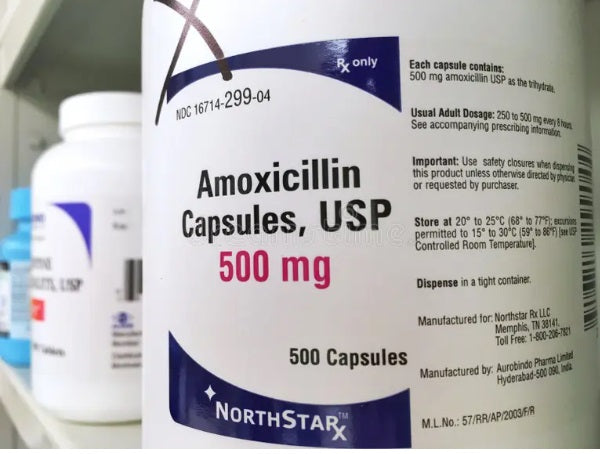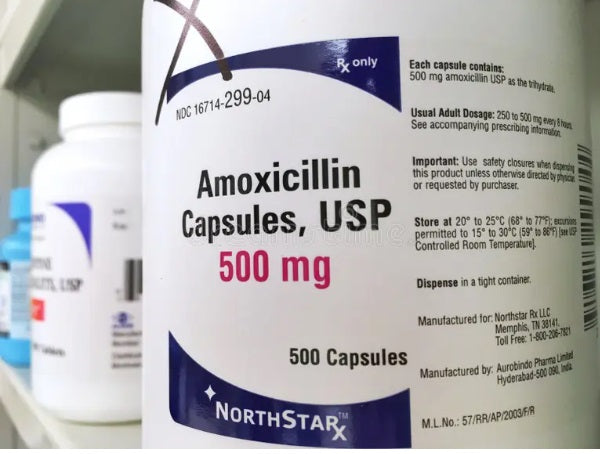Amoxicillin 500 mg: Reliable Antibiotic Treatment for a Variety of Infections
Amoxicillin 500 mg is a widely used antibiotic effective in treating a broad range of bacterial infections. It is part of the penicillin class of drugs and works by inhibiting the growth of bacteria. Whether you're dealing with a respiratory infection, urinary tract infection (UTI), skin infection, or even more severe bacterial conditions, Amoxicillin 500 mg provides reliable and effective relief.
Why Choose Amoxicillin 500 mg?
- Broad-Spectrum Antibiotic: Amoxicillin 500 mg is highly effective against a variety of bacterial infections, including ear infections, sinus infections, strep throat, pneumonia, and bronchitis.
- Well-Tolerated and Safe: It’s one of the most commonly prescribed antibiotics due to its low risk of severe side effects and its ability to treat many different bacterial infections.
- Convenient Dosage: The 500 mg strength allows healthcare providers to prescribe the right amount for both moderate and severe bacterial infections.
How Amoxicillin 500 mg Works:
Amoxicillin works by preventing the bacterial cell wall from forming, which is essential for the bacteria’s survival. This action makes it effective in treating bacterial infections by killing the bacteria or slowing their growth, allowing your immune system to eliminate the remaining infection.
How to Use Amoxicillin 500 mg:
- Dosage Instructions: The typical dose of Amoxicillin 500 mg is taken every 8 hours (three times a day) or as prescribed by your doctor. The exact dosage will depend on the severity of the infection and your doctor’s advice. It’s essential to follow your healthcare provider’s instructions closely to ensure effectiveness.
- Complete the Full Course: Always complete the full course of Amoxicillin, even if you feel better before the prescribed duration is over. Stopping early may allow bacteria to survive, leading to a relapse or the development of antibiotic-resistant bacteria.
- Take as Directed: Take Amoxicillin with a full glass of water. You can take it with or without food, but if it upsets your stomach, taking it with food may help.
- Proper Storage: Store Amoxicillin 500 mg at room temperature, away from heat and moisture, and out of reach of children.
Potential Side Effects and Risks:
- Common Side Effects: Most people tolerate Amoxicillin 500 mg without issues. However, some may experience mild side effects such as nausea, diarrhea, headache, or rash. These side effects are usually temporary.
- Serious Side Effects: Although rare, Amoxicillin can cause severe allergic reactions, including swelling, difficulty breathing, or severe rash. If you experience any of these symptoms, seek emergency medical attention.
- Risk of Antibiotic Resistance: Overuse or misuse of antibiotics like Amoxicillin can contribute to the development of antibiotic resistance, where bacteria become resistant to treatment. Always follow your healthcare provider’s prescribed dosage and schedule.
- Drug Interactions: Amoxicillin 500 mg can interact with other medications, including blood thinners and other antibiotics. Make sure your doctor knows all the medications you are taking, including over-the-counter drugs and supplements.
- Take as Directed: Avoid taking more than the prescribed dose, as this can increase the risk of side effects.
Where to Buy Amoxicillin 500 mg Online in the USA:
Amoxicillin 500 mg is available online. It’s important to purchase only from reputable online sources that are FDA-approved to ensure the medication’s safety, quality, and authenticity. Be cautious of unverified websites selling potentially counterfeit products.
Penicillin is a widely known antibiotic used to treat a variety of bacterial infections. It belongs to the beta-lactam class of antibiotics and is effective against many types of gram-positive and some gram-negative bacteria. Penicillin works by inhibiting the synthesis of bacterial cell walls, ultimately leading to the destruction of the bacteria.
Common Uses of Penicillin
Penicillin is prescribed for the treatment of various bacterial infections, including:
- Strep throat
- Pneumonia
- Scarlet fever
- Skin infections
- Ear infections
- Sinusitis
- Dental infections
- Syphilis and other sexually transmitted infections
- Rheumatic fever prevention
The specific type of penicillin and its dosage depend on the nature and severity of the infection.
How Penicillin Works
Penicillin interferes with the formation of the bacterial cell wall by binding to proteins involved in the process. This action weakens the wall, causing the bacteria to burst and die, effectively clearing the infection.
Dosage and Administration
Penicillin is available in various forms, including tablets, capsules, liquid suspensions, and injectables. The dosage and frequency of administration depend on the type of infection being treated, patient age, and overall health. Tablets are typically taken orally, with or without food, as directed by a doctor. It’s important to complete the full course of treatment, even if symptoms improve before finishing the medication, to prevent antibiotic resistance and ensure the infection is fully eradicated.
Important Precautions
Before starting penicillin, inform your doctor if you:
- Are allergic to penicillin, cephalosporins, or any other medications.
- Have a history of asthma, kidney disease, or any significant medical condition.
- Are pregnant, planning to become pregnant, or breastfeeding. Penicillin is generally considered safe during pregnancy and breastfeeding, but medical advice should be sought.
Certain medications, including some over-the-counter drugs and supplements, can interact with penicillin. Be sure to disclose all medications you are taking to your doctor or pharmacist.
Potential Side Effects
While penicillin is typically well-tolerated, some individuals may experience side effects, including:
- Mild nausea or vomiting
- Diarrhea
- Headache
- Oral thrush or vaginal yeast infections
More serious side effects, which require immediate medical attention, may include:
- Severe allergic reactions (hives, swelling of the face, throat, or tongue, difficulty breathing)
- Severe diarrhea that may indicate a more serious intestinal condition (Clostridioides difficile infection)
- Rash or unusual skin reactions
Allergic Reactions
Penicillin allergy is one of the most common drug allergies. Symptoms may range from mild skin rashes to severe anaphylactic reactions. If you have a known penicillin allergy, alternative antibiotics will need to be considered. If any signs of an allergic reaction occur, such as itching, rash, swelling, or difficulty breathing, seek emergency medical attention immediately.
Storage and Handling
Penicillin tablets should be stored at room temperature, away from excessive heat, moisture, and light. Keep the medication out of reach of children and pets. Any unused or expired medication should be disposed of properly, and pharmacists can guide you on safe disposal practices.
Final Notes
Penicillin has saved countless lives since its discovery and remains an essential treatment for bacterial infections. However, misuse or overuse can contribute to antibiotic resistance. Always follow your doctor’s instructions, avoid self-prescribing, and never share antibiotics with others.


